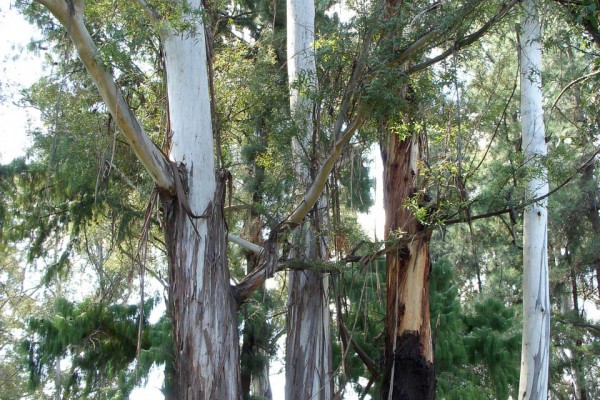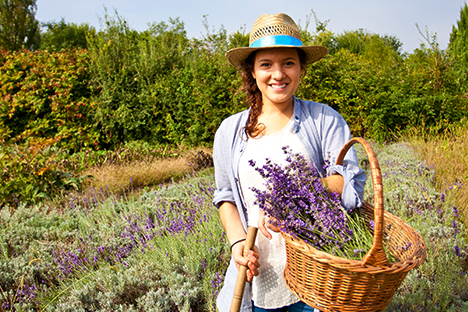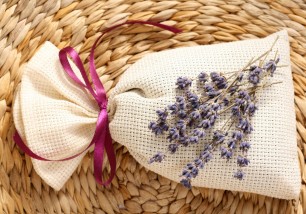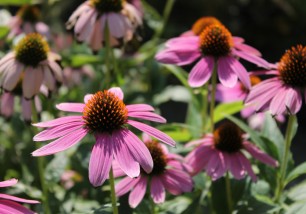EUCALYPTUS
BOTANICAL NAME:Eucalyptus globulus Labill.

PLANT DATA
| Common Name: | Eucalyptus |
| Botanical Name: | Eucalyptus globulus Labill. |
| Family: | Myrtaceae |
| Origin: | Tasmania and Australia |
| Other names: | ES: Eucalipto FR: Eucalyptus DE: Blaue Eukalyptus |
Latest tag


A large evergreen tree that can reach heights of up to 90 meters. It is easily recognizable for its characteristic clear, grey bark, which detaches itself in vertical stripes, revealing a smooth and bluish layer. It has very ample foliage: the younger branches have oval, opposite, whitish and waxy leaves without petiole. The more mature branches have alternate, petiolate, long, sickle-shaped leaves with a bluish color and a strong, aromatic smell because of the presence of numerous oil glands.
The flowers are solitary or in groups of two or three. The flowers can be white, pale yellow, red or pink, according to the species. The fruit is a capsule that contains many small seeds. Eucalyptus tree exudes a substance that accumulates on the bark in reddish or glassy lumps, called kino, consisting of tannin and other compounds.
OTHER SPECIES:
There are over 700 different species that belong to the Eucalyptus genus, of which at least 500 produce essential oil, though not all of therapeutic interest.
Eucalyptus globulus Labill: is the most important in the medical field, but other species are also used, such as:
- Eucalyptus polybractea
- Eucalyptus radiata var. australiana, called Eucalipto peperita angustifoglio
- Eucalyptus smithii or Gomma fetida.
- Eucalyptus camldulensis or rostrata.
In perfumery, the essential oil of Eucalyptus citriodora and Eucalyptus macarthuri are used because they are rich in citronellol and geraniol.
ESSENTIAL OIL
The essential oil is obtained through steam current distillation of the adult leaves and of the fresh or partially dried twigs. The yield is very variable according to the type of extraction used, the degree of drying of the leaves, and from the harvesting period. It can be between 0,5-3%. The highest yields are given from the use of younger leaves. The essential oil of Eucalyptus globulus is widely used in the herbal field for its richness in eucalyptol, an important molecule in diseases of the respiratory systems. By cutting into the eucalyptus bark, a red exudate is obtained that is called kino.
HERBAL TEA CUT
After having been harvested, the leaves and twigs can be used fresh or undergo drying. After drying and grinding, the tisane cut is obtained and used in the preparation of infusions and tisanes.
Climate and soil:
Eucalyptus needs full sun exposure. It is better to avoid shaded areas because there could be a premature loss of leaves. This plant prefers mild, warm and especially likes the maritime climates.
It is a very rustic plant that grows well with every kind of soil.
Planting and propagation:
Seed propagation is the main propagation method for Eucalyptus, using seeds coming from plants that are at least 5 years old, in order to assure a good level of germination.
To facilitate the emergence and growth of the seedlings, sowing is made in plastic pots. The seedlings will later be transplanted in larger pots until the planting, that is carried out 6 to 8 months after the sowing, in early/ mid Summer.
Another propagation method is by semi-wooden cuttings.
Cultivation care:
While the seedlings are still young, it is better to always keep the soil wet. When the first winter comes, it is a good practice to protect the stems from the cold using straw or mulch. The roots are delicate and don’t like to be moved frequently, for this reason it is advisable to transplant the seedlings in their final place. During the summer it is a good practice to water the trees at least once a month but generally speaking Eucalyptus is a plant that can survive during long periods without water.
Harvesting:
The main purpose of Eucalyptus cultivation is the production of wood, so leaves for essential oil extraction represent a secondary product.
In general, the collection of sickle-shaped leaves and twigs is done in Summer and Autumn.
Part of the plant used:
Adult plant leaves
Properties and uses:
Eucalyptus leaves have expectorant, mucolytic, antiseptic and anti-inflammatory activities. If administered in herbal tea form they are helpful against bronchitis, catarrh, and inflammation of the upper respiratory tract.
Eucalyptus essential oil stimulates the bronchial epithelium where it acts as an anti-inflammatory and as an antibacterial.
The utilization of pure essential oil for internal use is not recommended: external use is preferred (always diluted), for example for inhalations. It shows a balsamic effect and it is useful against cough.
Recent studies show a possible glucose-lowering activity of preparations made from Eucalyptus leaves. This suggests a possible beneficial effect in the treatment of diabetes.
The exudate (kino), obtained by incision of the bark, is used as an astringent for mouthwashes.
The kino on the market is obtained mainly from the species Eucalyptus camaldulensis.
Being a woody plant, Eucalyptus is also used for the production of cellulose.



